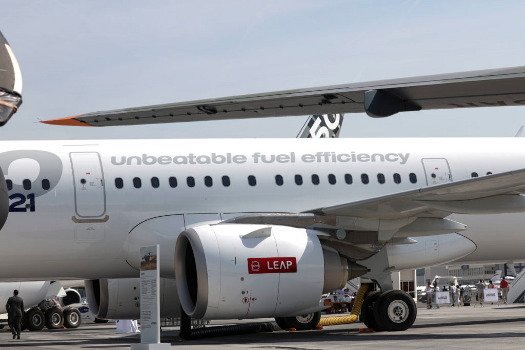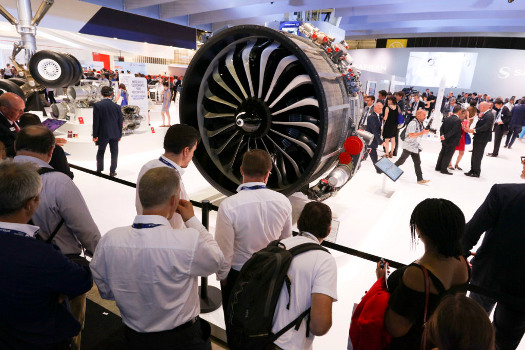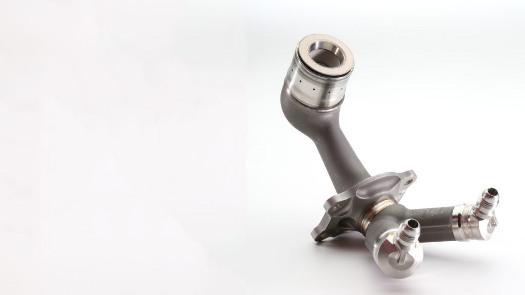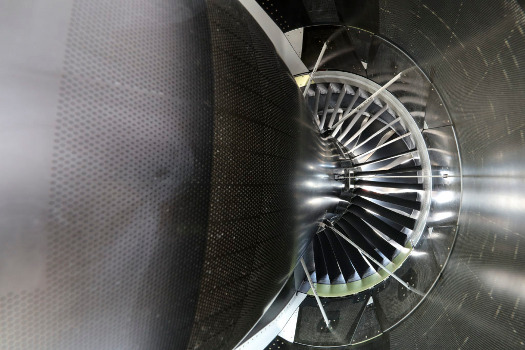 |
| July 25, 2017 | Volume 13 Issue 28 |
Designfax weekly eMagazine
Archives
Partners
Manufacturing Center
Product Spotlight
Modern Applications News
Metalworking Ideas For
Today's Job Shops
Tooling and Production
Strategies for large
metalworking plants
Engines with 3D-printed parts lift GE, partners: More than $31 billion in Paris Air Show orders

Planes powered by LEAP engines entered service last year and have already carried more than 5 million passengers. [Image credit: Rob Butler for GE Reports.]
By Tomas Kellner, GE Reports
Next-generation passenger jets powered by engines with 3D-printed parts dominated the 2017 Paris Air Show.
GE and its partners received more than $31 billion in new business at the show in June. The bulk of those orders were for a new family of LEAP jet engines with 3D-printed fuel nozzles. The LEAP engine was developed by CFM International, a 50-50 joint venture between GE and France's Safran Aircraft Engines.
CFM has received orders for 1,658 LEAP and other engines valued at $27.3 billion. This brings the total orders for the LEAP engines to more than 14,000, up from 12,500 before the show. "This air show has far surpassed all of our expectations," said CFM President and CEO Gaël Méheust.
CFM developed the LEAP for the next generation of single-aisle aircraft like the Airbus A320neo, Boeing 737 MAX, and China's COMAC C919. This is the fastest growing segment of the booming aviation market. The trade group International Air Transportation Association (IATA) estimates that global passenger volume will grow by 7.4 percent in 2017 and that the number of planes will increase by 3.8 percent. The typical aircraft today is also more than 80 percent full on average. IATA projects total airline profits at $30 billion this year.
Planes powered by LEAP engines entered service last year and have already carried more than 5 million passengers on airlines like AirAsia, easyJet, Frontier, WOW air, SAS, Azul, and Virgin America. They should help airlines add to the bottom line. Each engine holds up to 19 3D-printed fuel nozzles, which help improve its efficiency by as much as 15 percent. This is a huge deal considering that the engines will remain in service for decades.

The LEAP engine drew crowds at the 2017 Paris Air Show. [Image credit: Rob Butler for GE Reports.]
The nozzles rely on a complex internal geometry that allows them to mix and inject fuel in the engine efficiently. But the structure is so intricate that 3D printing is the only practical way to mass-produce them. "We tried to cast it eight times, and we failed every time," says Mohammad Ehteshami, who runs GE Additive, a new GE business dedicated to supplying 3D printers, materials, and engineering consulting services.
The LEAP engines also contain parts from other new materials that include "super ceramics." These materials, called ceramic matrix composites, are as tough as metals, but they are also one-third as heavy and can operate at 2,400 deg F. That's 500 degrees higher than the most advanced alloys. This combination allows engineers to design lighter components for engines that require less cooling air, generate more power, and burn less fuel. "This is a huge play for us," says GE Aviation's Sanjay Correa, who was involved in the engine's development.

The LEAP's fuel nozzles rely on a complex internal geometry that allows them to mix and inject fuel in the engine efficiently. But the structure is so intricate that 3D printing is the only practical way to mass produce them. [Image credit: CFM International]
The 69 Airbus and Boeing planes with LEAP engines currently in service fly on average for more than 10 hours a day, achieving 96 percent utilization, another important airline metric. "An airplane in service is an airplane making money," says Allen Paxson, the executive vice president of CFM.
Airlines can work the engines so hard in part because the company is using a "digital thread" to collect and analyze data spanning development, production, and service. GE says that apps running on Predix, the company's software for the industrial internet, are already monitoring some 35,000 jet engines. Software helps better predict when individual engines need service, among other things.
As a result of these technologies, LEAP engines are the perfect triple play for anyone who flies and operates an airline: It's good for the bottom line and good for the environment, and it can help lower ticket prices.

Airlines can work the LEAP engines so hard in part because CFM is using a "digital thread" to collect and analyze data spanning development, production, and service. [Image credit: Rob Butler for GE Reports]
Read more GE Reports at www.gereports.com.
Published July 2017
Rate this article
View our terms of use and privacy policy
